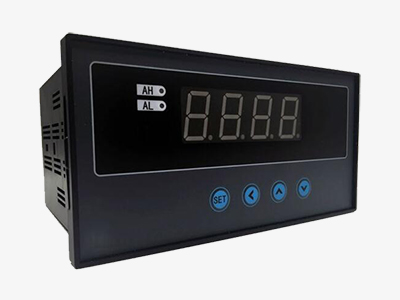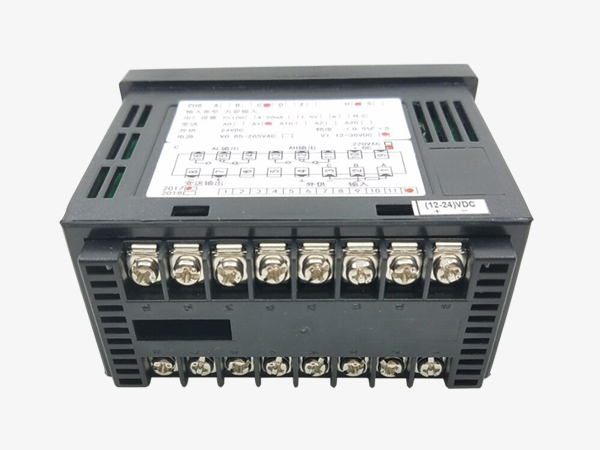Single input channel Intelligent digital panel meter can be used with variety of analog output sensors and transmitters to accomplish the measurement, transfer, display, transmission, recording and control of temperature, pressure, level, component, force and displacement, etc.

Display panel meter
- 4 digit digital panel meter can be easily connected with any electronic ruler, and it is convenient and intuitive to display the displacement distance value.
- Display decimal position can be set, with upper and lower limit alarm function. And the number of alarm points can be increased.

Multi-function digital panel meter
- sisco 4 digit digital panel meter has the functions of adjustment, digital filtering and zero reset at any position. The error is less than 0.5%F.S.
- Digital panel meter is suitable for standard voltage, current, RTD, thermocouple and other signal types.
- It comes with transmission output, which can output the measured and transformed display values in the form of standard current and voltage for use by other devices.
Applications
sisco digital panel meter is widely used in voltage stabilizers, spot welding machines, calibration benches and various electrical equipment and control systems that have certain restrictions on the size of the instrument.

| Basics | Model | SISCO-DPM-DS4D-CH6 |
| Dimension (W*H*L) | D1: 160*80*125mm horizontal, hole size 152*76mm; D2: 80*160*125mm vertical, hole size 76*152mm; D3: 96*96*76mm, hole size 92*92mm; D4: 96*48*82mm horizontal, hole size 92*45mm; D5: 48*96*82mm vertical, hole size 92*45mm; D6: 72*72*75mm, hole size 68*68mm; D7: 48*48*108mm, hole size 45.5*45.5mm. |
|
| Shipping weight | 2 kg | |
| Technical parameters | Display | -1999~9999 |
| Measurement accuracy | <0.5% | |
| Measuring speed | 10 times/second | |
| Display method | 4 digit LED display; 4 digit LED display + setting | |
| Instrument power supply | 100-240VAC, 50/60Hz | |
| Universal signal input | DC current 4-20mA, 0-20mA, 0-10mA; DC voltage 0-5V, 1-5V; RTD sensor: Pt100 (-200~+500℃), Cu100 (-50~+150℃), Cu50 (-50~+150℃), BA1 (-200~+650℃), BA2 (-200~+500℃), G53 (-50~+150℃); Thermocouple: K type (-100~+1300℃), S type (0~+1700℃), R type (0~+1700℃), B type (500~1800℃), N type (-100~+1300℃), E type (-100~+800℃), J type (-100~+1100℃), T type (-100~+400℃). *Note: DC voltage 0-10V input need to be customized and can't be a universal signal input. |
|
| Alarm | AH and AL alarm | |
| Additional power supply (optional) | P0: No power supply; P1: DC 24V±5%, <50mA; P2: DC 12V±5%, <50mA. *Note: Additional power supply can provide DC power supply for other devices such as sensors. |
|
| Output signal (optional) | T0: No output signal; T1: Current output (4-20mA), (0-10mA), (0-20mA); T2: Voltage output (0-5V), (1-5V); T3: Voltage output (0-10V). *Note: DC voltage 0-10V output need to be customized. |
Q1: What is a digital panel meter?
A1: The digital panel meter displays the voltage, current value or other standard signal transmission display value in the electrical circuit by digital direct reading; the product has the advantages of good stability, strong anti-interference, high cost performance, and the product is small in size and can be directly replaced original pointer meter.
Q2: What are the functions of digital panel meters?
A2: Digital panel meters can be categorized by type, size, style or other criteria. Understanding the functions of the digital panel meter is an important factor in choosing it. Commonly used functions are ammeters, voltmeters, frequency meters, power meters, energy meters, counters, timers, thermometers, process meters and controllers.
Q3: What are the advantages of digital panel meters?
A3: The digital panel meter directly displays the measured value or deviation value by digital quantity, which is clear and intuitive, easy to read, and will not produce parallax. Digital panel meters generally use large and medium-scale integrated circuits, with simple circuits, good reliability and good shock resistance. Because of the common modular design method for instruments, that is, digital panel meters are mostly composed of a small number of modular circuits with separated functions, so they are conducive to manufacturing, debugging and maintenance.
Tips: How to calibrate digital panel meter?
When a new system is used for the first time or when the digital panel meter is replaced, it must be calibrated before use. There are generally two calibration methods, one is physical calibration, and the other is digital calibration.
Physical calibration is available for most weighing systems, and digital calibration is used in areas where physical calibration is not possible. But digital calibration does not eliminate errors, and its accuracy is related to the sensitivity of the sensor, range and wiring system (four- or six-wire), cutoff or maximum range settings, and signal loss on junction boxes and cables.
Before calibration, the digital panel meter should be powered on for at least 15 minutes until the sensor and meter reach thermal equilibrium. The sensor cable and the connection cable between the junction box and the panel meter should be completely bound. In addition, the scale body should be pressed with a full-size object for more than 8 hours to stabilize the mechanical structure of the equipment. Otherwise, a few days after the new device was calibrated, the meter reading could suddenly change, resulting in inaccurate weighing.
Some digital panel meters have zero tracking function. The zero tracking function will not be automatically turned off during calibration, please turn off the digital panel meter manually, and then turn it on after the calibration is completed. During calibration, after the system is stable (the MD indicator light is off), press the OK key to accept the weighing value.
Thank you for buying industrial test and measurement equipment on SISCO.com, all products sold by SISCO and the partner cover a 12 months warranty, effective from the date of receiving the products.
What is covered?
SISCO is responsible for providing free spare parts, and free technical support to assist the customer to repair the defective products until the problem is solved.
What is not covered?
- Product purchased from anyone other than a SISCO store or a SISCO authorized reseller.
- Expendable parts.
- Routine cleaning or normal cosmetic and mechanical wear.
- Damage from misuse, abuse or neglect.
- Damage from use of parts other than SISCO approved.
- Damage from use outside the product’s usage or storage parameters.
- Damage from use of parts not sold by SISCO.
- Damage from modification or incorporation into other products.
- Damage from repair or replacement of warranted parts by a service provider other than a SISCO authorized service provider.
- Damage caused by the application environment not meeting the product usage requirements and the failure to perform preventive maintenance.

